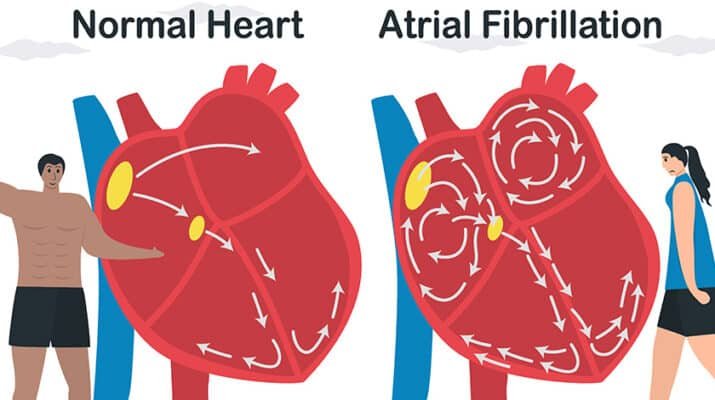By Ernst Lamothe Jr.
It’s a condition that results in more than 454,000 hospitalizations in the United States each year. Even worse, the Centers for Disease Control and Prevention predict around 12.1 million people could be diagnosed with the ailment by 2031.
Atrial fibrillation — or a-fib — is an abnormal heart rhythm from the top chambers of the heart. This often causes the heart to beat irregularly and quickly. The risks of atrial fibrillation include stroke and, if the heart rate is fast, a weaken heart.
“Heart arrhythmia is more common than people believe and it is associated with an increased risk of stroke. The rate of the condition dramatically increases as someone gets older,” said physician Anne B. Curtis, distinguished professor of medicine at the University at Buffalo Jacobs School of Medicine & Biomedical Sciences.
She explains five things you should know about a-fib.
1 — Symptoms

Atrial fibrillation often presents with racing heartbeats, irregular heartbeats and a lack of stamina. However, many patients have no symptoms, particularly those whose heart rates are not as fast when they are in atrial fibrillation. Other symptoms include lightheadedness, extreme fatigue, shortness of breath and chest pains. A normal heartbeat begins with one electrical impulse from the sinus node, a single point in the heart’s right atrium. A healthy person’s heart usually beats 60 to 150 beats per minute. With a-fib, electrical impulses fire from multiple sites in both atria. That can cause the atria to contract 400 or more times per minute. The ventricles become overwhelmed trying to keep up with the contractions.
“Patients will complain about palpitations, shortness of breath and fatigue, and when untreated, that can lead to heart failure,” said Curtis. “When your heart has to work harder than normal that affects your overall body and you simply feel exhausted. Sometimes my patients don’t even feel the palpitations so that is why it is essential to go to your regular physician visits to make sure everything is going well with your heart.”
2 — Prevention
A healthy lifestyle with regular aerobic exercise and a well-balanced diet helps reduce your risk of atrial fibrillation and other forms of heart disease. Exercise works like beta-blocker medication to slow the heart rate and lower blood pressure at rest and also when exercising. A combination of aerobic workouts — including walking, running, swimming — in combination with strength training, remains the ideal combination for great heart health. High blood pressure is a major risk factor for heart disease. In addition, experts recommend avoiding tobacco and smoking. Whether it’s your eating habits leading to diabetes or the way you handle your environment leading to stress and high blood pressure, she also suggests making sure to monitor those aspects of life.
“Many of the ways you can improve your life have to do with lifestyle. You are at a higher risk if you have high blood pressure, sleep apnea or have obesity issues,” said Curtis. “We recommend exercising appropriately because consistent movement and being in shape is ideal. We also recommend not over exercising. Many marathoners and elite athletes are at higher risk for a-fib than the general population so they have to watch their heart rates when they practice or compete.”
Episodes of atrial fibrillation may come and go, or they may be persistent. However, even though the condition isn’t always life-threatening it has the possibility of leading to more serious medical conditions that require proper treatment.
3 — Family history
Family history may play a role in atrial fibrillation. Certain genes have been identified as associated with atrial fibrillation. If you have familial atrial fibrillation, you may get it earlier in life than do those without a family history of the condition.
“I would say it is very unusual that family history plays an issue. There have been studies that talk about some genetic correlation and ethnicity does play a factor,” she added.
Asian and Black populations see lower atrial fibrillation rates than those of European ancestry.
4 — Misconceptions
A common misconception about atrial fibrillation is that a pacemaker is the first and best therapy. A pacemaker does not keep the heart beating regularly. It increases the heart rate.
“It’s very rare to have a specific gene lead to A-fib in a family, but it can occur. Much more often, obesity, hypertension and sleep apnea may run in a family, and those conditions make a-fib more likely,” Curtis said.
5 — Stroke
People with atrial fibrillation have three to five times greater risk for ischemic stroke. “The stroke risk is real and it is worth pointing out,” said Curtis. “If someone has diabetes and hypertension then they are at higher risk because sometimes you have blood thinning medication when you are diagnosed with a-fib to prevent a stroke.”

